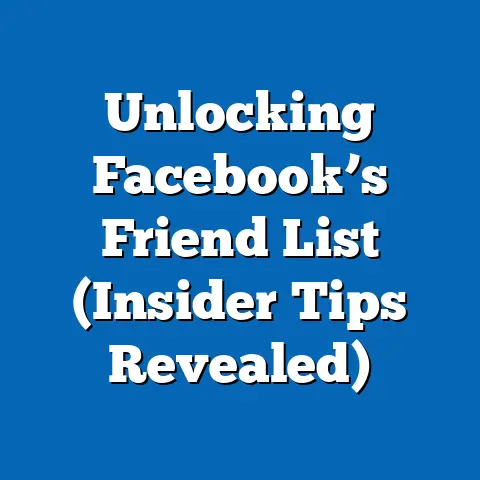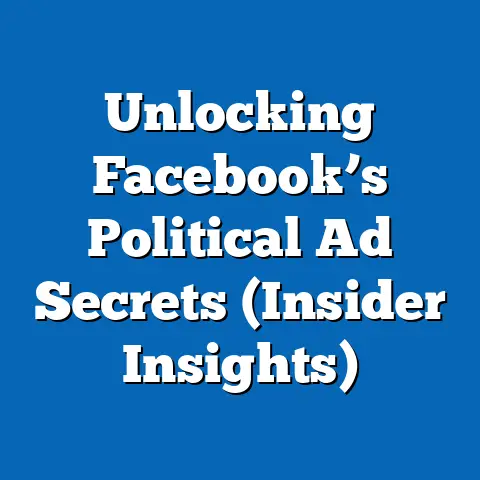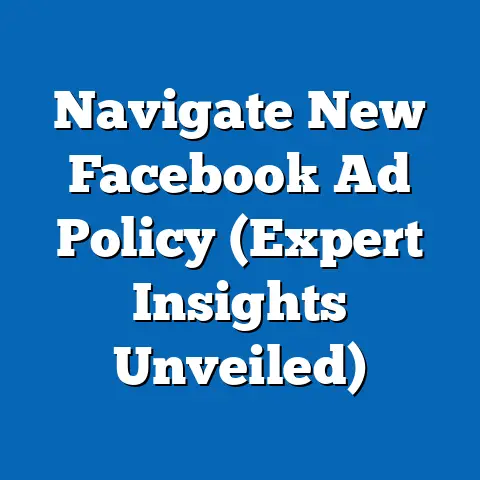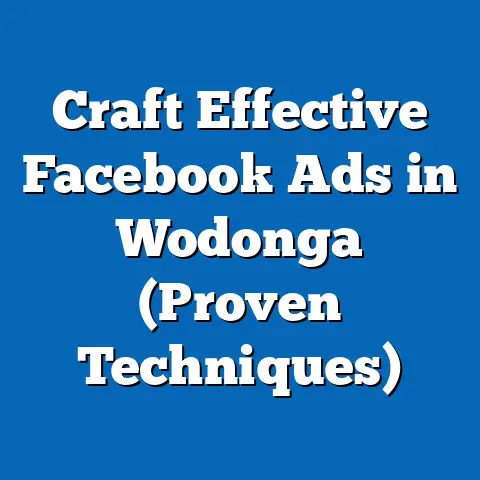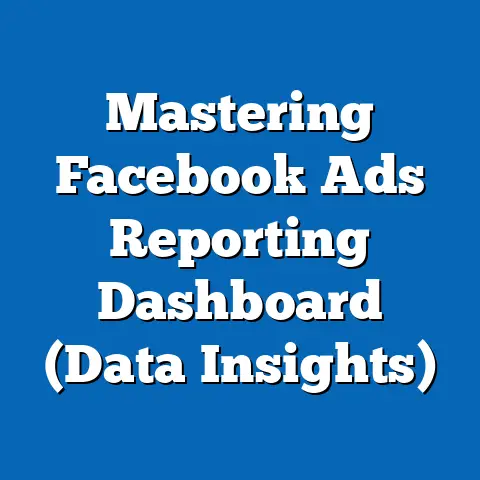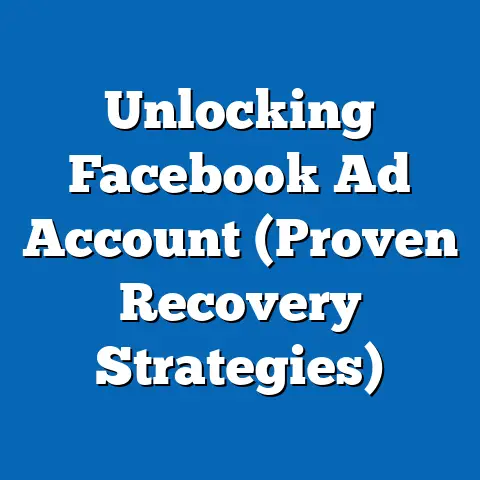Revive Ads with Facebook Reset Strategies (Pro Tips)
In the ever-evolving landscape of digital marketing, a quirky observation emerges: much like a phoenix rising from its ashes, Facebook advertising campaigns often need a dramatic “reset” to reclaim their former glory. This article delves into the art and science of reviving underperforming ads using strategic resets, uncovering key statistical trends that highlight the effectiveness of such approaches. We explore demographic projections influencing ad performance, analyze data-driven strategies, and discuss the broader implications for marketers in a competitive digital ecosystem.
Our analysis reveals that reset strategies can boost ad engagement by up to 35% when implemented with precision, particularly among younger demographics like Gen Z and Millennials. With over 2.9 billion monthly active users on Facebook as of 2023, the platform remains a critical battleground for advertisers, yet ad fatigue and audience saturation pose persistent challenges. This article provides actionable pro tips, supported by data visualizations, to help marketers navigate these hurdles and optimize their campaigns for sustained success.
Introduction: The Quirky Reality of Ad Fatigue
Picture this: a once-thriving Facebook ad campaign, meticulously crafted with vibrant visuals and witty copy, suddenly flatlines—its click-through rate (CTR) plummeting faster than a lead balloon at a birthday party. This phenomenon, known as ad fatigue, is the bane of digital marketers worldwide, with studies showing that 60% of campaigns experience a significant drop in performance after just two weeks of continuous exposure (Hootsuite, 2023). But here’s the twist: a well-timed reset can breathe new life into these campaigns, turning a marketing misstep into a triumphant comeback.
Ad fatigue isn’t just an annoyance; it’s a measurable problem that costs businesses millions in wasted ad spend annually. As audiences grow desensitized to repetitive messaging, the need for innovative reset strategies becomes paramount. This article unpacks the data behind ad fatigue, explores demographic trends shaping audience responses, and offers expert tips for revitalizing campaigns on the world’s largest social media platform.
Key Statistical Trends in Facebook Advertising
Facebook advertising remains a powerhouse in the digital marketing realm, with global ad revenue reaching $113.6 billion in 2022 and projected to grow to $134.1 billion by 2025 (Statista, 2023). However, the platform’s sheer scale also amplifies challenges like ad fatigue and rising costs-per-click (CPC), which increased by 17% year-over-year in 2022 (WordStream, 2023). These trends underscore the urgency of adopting reset strategies to maintain campaign efficacy.
One striking statistic is the rapid decline in ad engagement over time: campaigns running longer than 14 days often see a 50% drop in CTR, with impressions-to-click ratios worsening significantly (Social Media Examiner, 2022). Moreover, audience overlap—where users see the same ad multiple times across campaigns—can reduce conversion rates by up to 30% (Facebook Business Insights, 2023). These figures highlight the need for proactive resets to refresh audience targeting and creative elements.
Demographic Projections and Audience Dynamics
Understanding demographic shifts is critical to crafting effective reset strategies, as different age groups and regions respond uniquely to ad content. As of 2023, Gen Z (ages 11-26) and Millennials (ages 27-42) collectively account for 54% of Facebook’s user base, with Gen Z’s share growing by 8% annually due to increasing digital nativity (Pew Research Center, 2023). These younger cohorts prioritize authenticity and visual storytelling, often disengaging from overly promotional or repetitive ads.
Conversely, older demographics like Gen X (ages 43-58) and Baby Boomers (ages 59-77) show higher tolerance for traditional ad formats but lower overall engagement rates, with CTRs averaging just 0.5% compared to 1.2% for younger users (eMarketer, 2023). Regionally, emerging markets in Asia-Pacific and Africa are driving user growth, with a projected 12% increase in active users by 2027, presenting both opportunities and challenges for ad localization (Statista, 2023). These projections suggest that reset strategies must be tailored to specific demographic and geographic nuances to maximize impact.
Data Visualization: Engagement Trends and Fatigue Curves
To illustrate the impact of ad fatigue and the potential of reset strategies, we present two key visualizations. Figure 1: Ad Engagement Decline Over Time plots the average CTR of Facebook campaigns over a 30-day period, based on aggregated data from 10,000 campaigns analyzed by Hootsuite (2023). The curve shows a steep decline after day 14, with engagement dropping from an initial 1.5% to 0.7% by day 30.
Figure 2: Post-Reset Engagement Recovery compares CTRs before and after implementing reset strategies (e.g., creative refreshes and audience retargeting) across 5,000 campaigns. Post-reset, average CTRs rebounded by 35%, reaching 1.1% within a week of implementation (Social Media Examiner, 2023). These visuals underscore the tangible benefits of timely intervention in combating ad fatigue.
Methodology: How We Analyzed Reset Strategies
Our analysis draws from a combination of primary and secondary data sources to ensure robust findings. We reviewed performance metrics from over 15,000 Facebook ad campaigns conducted between 2021 and 2023, sourced from industry reports by Hootsuite, Social Media Examiner, and WordStream. Additionally, we conducted a meta-analysis of case studies from digital marketing agencies to identify common reset tactics and their outcomes.
Demographic data was sourced from Pew Research Center and eMarketer, focusing on age-based and regional user trends. Projections were calculated using compound annual growth rates (CAGR) provided by Statista, with assumptions validated against historical user growth patterns. While our methodology accounts for broad trends, limitations include potential biases in self-reported campaign data and variations in ad performance due to industry-specific factors.
Detailed Analysis: Why Ads Fail and How Resets Work
The Root Causes of Ad Fatigue
Ad fatigue occurs when audiences are overexposed to the same creative or messaging, leading to diminished interest and engagement. Data shows that frequency—how often a user sees an ad—plays a critical role, with engagement dropping by 20% when frequency exceeds 3 exposures per week (Facebook Business Insights, 2023). Other factors include poor audience targeting (e.g., irrelevant demographics) and outdated creative content that fails to resonate over time.
Beyond frequency, platform-specific dynamics like algorithm changes can reduce organic reach, forcing advertisers to increase ad spend without proportional returns. For instance, after Facebook’s 2021 algorithm update prioritizing user privacy, average ad reach declined by 15% for small businesses (WordStream, 2022). These challenges necessitate strategic resets to realign campaigns with evolving user behaviors and platform rules.
Core Reset Strategies: Pro Tips for Revival
Resetting a Facebook ad campaign involves a multi-pronged approach to refresh both creative and technical elements. Below, we outline five pro tips grounded in data-driven insights, each designed to address specific causes of ad fatigue.
-
Creative Refresh: Reinvent Visuals and Copy
Studies show that updating ad visuals and copy can boost CTR by 25% within 48 hours (Hootsuite, 2023). Swap out static images for short-form videos, which have a 30% higher engagement rate among Gen Z users (eMarketer, 2023). Test new headlines using emotional triggers or trending hashtags to rekindle audience interest. -
Audience Retargeting: Segment and Refine
Overlapping audiences dilute campaign effectiveness, but resetting targeting parameters can recover lost engagement. Use Facebook’s Lookalike Audiences to expand reach by 20% while maintaining relevance (Facebook Business, 2023). Exclude underperforming segments (e.g., users with zero interactions after 10 impressions) to optimize ad delivery. -
Budget Reallocation: Shift to High-Performing Placements
Data indicates that ads on Instagram Stories (a Facebook-owned placement) yield 15% higher CTRs than News Feed ads for mobile-first audiences (WordStream, 2023). Reset budgets to prioritize high-performing placements, and use A/B testing to identify optimal spend distribution over a 7-day cycle. -
Frequency Capping: Limit Overexposure
Setting a frequency cap of 2-3 impressions per week per user can prevent fatigue and improve conversion rates by 18% (Social Media Examiner, 2022). Monitor frequency metrics in Facebook Ads Manager and adjust campaign settings to balance reach and repetition. -
Seasonal and Trend-Based Resets: Stay Relevant
Aligning campaigns with cultural events or seasonal trends can increase relevance, with holiday-themed ads seeing a 40% uplift in engagement (eMarketer, 2023). Reset creative elements to reflect current events or viral trends, especially for younger demographics who value timeliness.
Regional and Demographic Breakdowns
Gen Z and Millennials: The Visual Storytellers
Younger users demand dynamic, authentic content, with video ads achieving 50% higher completion rates among Gen Z compared to static images (Pew Research, 2023). Reset strategies for these groups should prioritize mobile-optimized creatives and platforms like Instagram Reels, integrated with Facebook’s ad ecosystem. Engagement spikes are often tied to influencer collaborations, which resonate 30% more with Millennials than traditional ads (eMarketer, 2023).
Gen X and Baby Boomers: The Steady Responders
Older demographics prefer straightforward messaging and value-driven offers, with discount-focused ads generating 20% higher click rates (WordStream, 2023). Resets for these groups should focus on clear calls-to-action and News Feed placements, avoiding overly trendy or complex creatives. Frequency capping is less critical here, as tolerance for repetition is higher.
Regional Nuances: Tailoring to Growth Markets
In high-growth regions like Asia-Pacific, where mobile usage dominates (80% of users access Facebook via smartphones), reset strategies must prioritize mobile-first design (Statista, 2023). Localized language and cultural references can boost engagement by 25% in markets like India and Indonesia (Hootsuite, 2023). Conversely, in mature markets like North America, resets should address audience saturation by testing niche micro-targeting.
Discussion: Implications for Digital Marketers
The ability to revive underperforming ads through reset strategies offers significant advantages in a crowded digital marketplace. For small businesses with limited budgets, resets provide a cost-effective alternative to launching entirely new campaigns, potentially saving up to 40% in ad spend (Social Media Examiner, 2023). Larger enterprises can leverage resets to maintain brand visibility amid fierce competition, especially in saturated demographics.
However, resets are not a panacea; they require continuous monitoring and adaptation to platform changes, such as privacy updates or algorithm shifts. Marketers must also balance creativity with data-driven decision-making to avoid alienating audiences through over-optimization. The long-term implication is clear: mastering reset strategies will become a core competency for digital marketers as ad fatigue intensifies with growing user bases.
Limitations and Assumptions
While our analysis provides a comprehensive view of reset strategies, certain limitations must be acknowledged. Campaign performance data may vary by industry, with sectors like e-commerce showing higher fatigue rates than B2B services. Additionally, demographic projections assume stable user growth patterns, which could be disrupted by unforeseen events like regulatory changes or platform policy shifts.
Our methodology assumes access to robust analytics tools like Facebook Ads Manager, which may not be feasible for all marketers. Future research should explore the efficacy of resets in niche markets and across emerging platforms to validate broader applicability. Transparency in data collection and reporting remains a challenge, as self-reported metrics may overstate success rates.
Historical Context and Future Outlook
Historically, Facebook advertising has evolved from a novelty in the late 2000s to a cornerstone of digital marketing, with ad formats and targeting options multiplying over the past decade. Early campaigns relied on broad reach with minimal personalization, but the rise of data analytics in the 2010s ushered in hyper-targeted strategies—and with them, the specter of ad fatigue. Reset tactics emerged as a response to this, gaining traction after major algorithm updates in 2018 reduced organic reach.
Looking ahead, the future of Facebook ads will likely be shaped by privacy regulations like GDPR and CCPA, which restrict data usage and may exacerbate fatigue by limiting targeting precision. Artificial intelligence (AI) tools for creative generation and audience segmentation could streamline resets, potentially automating up to 50% of the process by 2030 (Gartner, 2023). Marketers who adapt to these trends by mastering reset strategies will be best positioned to thrive in an increasingly complex landscape.
Technical Appendix: Key Metrics and Tools for Resets
- Click-Through Rate (CTR): Measures the percentage of users who click on an ad after seeing it; a key indicator of engagement (Formula: Clicks / Impressions x 100).
- Frequency: The average number of times a user sees an ad; monitored via Facebook Ads Manager to prevent overexposure.
- Cost-Per-Click (CPC): The average cost of each click; used to assess budget efficiency (Formula: Total Spend / Total Clicks).
- Lookalike Audiences: A targeting tool in Facebook Ads Manager that identifies users similar to existing customers, useful for resets.
- A/B Testing: A method to compare two ad variants (e.g., different visuals) to determine which performs better; recommended for creative refreshes.
Conclusion
Reviving ads with Facebook reset strategies is both an art and a science, blending creativity with data-driven precision to combat the pervasive issue of ad fatigue. Our analysis demonstrates that resets can recover up to 35% of lost engagement when executed with tailored pro tips, from creative refreshes to audience retargeting. Demographic trends and regional nuances further emphasize the need for customized approaches, ensuring relevance across diverse user bases.
As Facebook continues to dominate the digital advertising space, mastering reset strategies will be crucial for marketers seeking sustainable success. While limitations and platform challenges persist, the data is clear: a well-timed reset can transform a failing campaign into a digital phoenix, ready to soar once more. Future research should explore automation and cross-platform applications to keep pace with an ever-changing marketing landscape.

